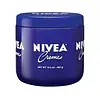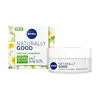What's inside
What's inside
 Key Ingredients
Key Ingredients

No key ingredients
 Benefits
Benefits

 Concerns
Concerns

 Ingredients Side-by-side
Ingredients Side-by-side

Water
Skin ConditioningGlycerin
HumectantCetearyl Alcohol
EmollientAlcohol Denat.
AntimicrobialPrunus Amygdalus Dulcis Oil
Skin ConditioningSimmondsia Chinensis Seed Oil
EmollientDicaprylyl Ether
EmollientButyrospermum Parkii Butter
Skin ConditioningGlyceryl Stearate
EmollientCaprylic/Capric Triglyceride
MaskingChamomilla Recutita Flower Extract
MaskingHelianthus Annuus Seed Oil
EmollientTocopherol
AntioxidantMaltodextrin
AbsorbentGlyceryl Caprylate
EmollientSodium Stearoyl Glutamate
CleansingXanthan Gum
EmulsifyingLevulinic Acid
PerfumingSodium Levulinate
Skin ConditioningDecylene Glycol
Skin ConditioningEthylhexylglycerin
Skin ConditioningP-Anisic Acid
MaskingSodium Chloride
MaskingWater, Glycerin, Cetearyl Alcohol, Alcohol Denat., Prunus Amygdalus Dulcis Oil, Simmondsia Chinensis Seed Oil, Dicaprylyl Ether, Butyrospermum Parkii Butter, Glyceryl Stearate, Caprylic/Capric Triglyceride, Chamomilla Recutita Flower Extract, Helianthus Annuus Seed Oil, Tocopherol, Maltodextrin, Glyceryl Caprylate, Sodium Stearoyl Glutamate, Xanthan Gum, Levulinic Acid, Sodium Levulinate, Decylene Glycol, Ethylhexylglycerin, P-Anisic Acid, Sodium Chloride
 Reviews
Reviews

Ingredients Explained
These ingredients are found in both products.
Ingredients higher up in an ingredient list are typically present in a larger amount.
Glycerin is already naturally found in your skin. It helps moisturize and protect your skin.
A study from 2016 found glycerin to be more effective as a humectant than AHAs and hyaluronic acid.
As a humectant, it helps the skin stay hydrated by pulling moisture to your skin. The low molecular weight of glycerin allows it to pull moisture into the deeper layers of your skin.
Hydrated skin improves your skin barrier; Your skin barrier helps protect against irritants and bacteria.
Glycerin has also been found to have antimicrobial and antiviral properties. Due to these properties, glycerin is often used in wound and burn treatments.
In cosmetics, glycerin is usually derived from plants such as soybean or palm. However, it can also be sourced from animals, such as tallow or animal fat.
This ingredient is organic, colorless, odorless, and non-toxic.
Glycerin is the name for this ingredient in American English. British English uses Glycerol/Glycerine.
Learn more about GlycerinWater. It's the most common cosmetic ingredient of all. You'll usually see it at the top of ingredient lists, meaning that it makes up the largest part of the product.
So why is it so popular? Water most often acts as a solvent - this means that it helps dissolve other ingredients into the formulation.
You'll also recognize water as that liquid we all need to stay alive. If you see this, drink a glass of water. Stay hydrated!
Learn more about Water